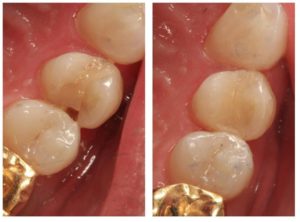 There once was a time when a cavity filling automatically meant that you’d be wearing some metal hardware, alerting everyone of the work that had been done. With advancements in the world of dentistry, though, there is another option available, now – tooth colored fillings. As you read on, your dentist in Pittsburgh will explain the differences between these two forms of restoration.
There once was a time when a cavity filling automatically meant that you’d be wearing some metal hardware, alerting everyone of the work that had been done. With advancements in the world of dentistry, though, there is another option available, now – tooth colored fillings. As you read on, your dentist in Pittsburgh will explain the differences between these two forms of restoration.
What’s an Amalgam Filling?
Traditionally, the metal (amalgam) filling has been used to restore teeth with cavities. Consisting of a mixture of silver, mercury, tin and copper, these fillings have been the standard because of a few reasons:
- Durability
- Cost-effectiveness
- Hardens quickly at application
- Takes less time to place
Metal fillings have been especially popular for back teeth because of how they function in chewing food and the amount of pressure that they’re forced to withstand.
There is an alternative available, though, for those who desire a more discreet treatment route.
Tooth-Colored Fillings Explained
Made of a composite resin material, tooth-colored fillings completely change the landscape of this type of restoration. No longer is it just functional; it now has an aesthetic feature to it.
Here are some of the advantages of tooth-colored fillings:
- Appearance – They blend right in with your other teeth, because beforehand, your dentist will take the time to find the perfect shade of material to match the color of your other ivories.
- A Tight Bond – One of the downsides of the amalgam method is that the metal never bonds with your enamel. Thus, your dentist is required to remove more of your tooth material to complete the procedure. Tooth-colored fillings, on the contrary, bond well with your enamel, preserving more of your tooth.
How the Process Works
The procedure for getting a tooth-colored filling involves your dentist doing the following:
- The first step is to apply a local anesthesia.
- Next, any tooth decay is removed.
- Your dentist will then prepare the tooth for the bonding by etching the surface with an acidic compound.
- Next, the resin is applied and hardened using a special light.
- The final step is to polish the tooth.
At the completion of these steps, you’ll have a fully restored tooth that blends in perfectly.
With the advancements in the field of dentistry, you no longer have to feel restricted to just one way of restoring your tooth’s function. You now have access to both cosmetic and functional applications at the same time.
To learn more about the tooth-colored filling and how it can benefit you, reach out to your dentist to schedule an appointment.
About the Author
A graduate of the University of Pittsburgh School of Dental Medicine in 1980, Dr. Ray Voller has nearly four decades of experience practicing dentistry. Still, he maintains a constant drive to be better, which is why he maintains memberships with several professional organizations. At Voller Dentistry, patients will find a warm, yet technologically advanced environment, where their dental needs will be met and exceeded. Dr. Voller can be reached for more information through his website.
